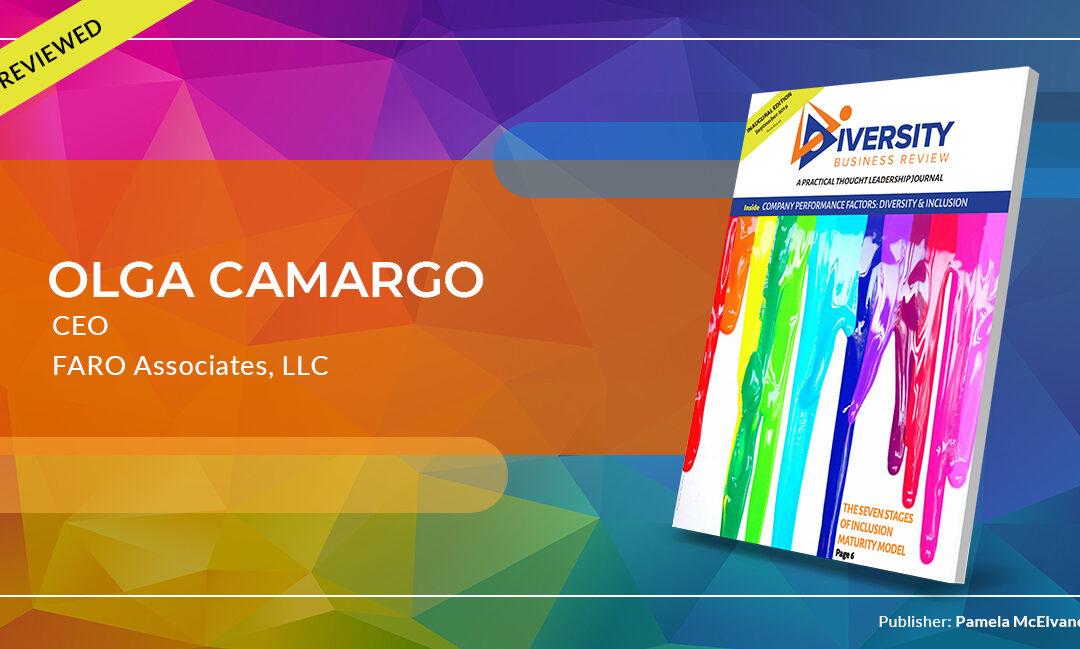
Barriers Facing Latinos Trying to Build Retirement Wealth
Olga Camargo,
CEO,
FARO Associates, LLC
Originally posted on https://www.diversitybusinessreview.com/barriers-facing-latinos-trying-to-build-retirement-wealth/
Having served as a retirement plan advisor for several years to diverse organizations and given my own personal background as a U.S. Latina, I am conditioned to thinking of ways to help our diverse workforce improve their ability to create wealth and tackle cultural barriers among others that get in the way of doing so—front and center in my mind is the U.S. Latino workforce and our brothers and sisters in other minority communities. As I reflect on U.S. Latinos numbers and purchasing power, I think about the community’s ability to position itself to build unprecedented wealth—certainly a benefit to our overall economy, but we must work to remove wealth building barriers if we are committed to tackling the Latino retirement crisis that is threatening the largest ethnic group in the U.S.
According to the Pew Research Center, the U.S. Latino population reached 60 million in 2018, and had purchasing power of $1.7 trillion in 2018 as noted in a Forbes article entitled, “Six Facts About The Hispanic Market That May Surprise You.” The fact remains, however, that even with all of the mighty purchasing power that Latinos have they still have many challenges in building wealth for themselves. Prosperity Now states that in 2016, Latino household wealth was only $6,300 compared to White America, who held $140,500.
The current situation is dire and as a practitioner not only do I see Latinos’ low retirement program participation rate (30.9% versus 53% for White workers, according to UnidosUS); but not saving enough exacerbates the problem. Unfortunately, the large wage gap that exists, especially for Latinas, does not help the current situation. In fact, last November 2018, a Forbes article titled, “How To Close the Wage Gap for Latina Employees” pegged November 1st as Latina Equal Pay Day, meaning that it would take a Latina 10 months and one day plus all of 2017 to make the same amount that a White man made in 2017 alone, put it another way Latinas earn $0.53 for every $1 that White men earn.
The current racial wealth gap is clearly an issue and that it why discounted annual incomes for minority communities like the Latino community can only go so far as related to retirement savings. So let’s not add insult to injury as we try to help build wealth within minority communities by allowing financial wealth-building obstacles that can be removed to continue being a part of the issue. As we collectively look forward, if we do nothing to tackle the Latino retirement crisis, also taking a toll on other minority communities, then we and our future generations will pay the consequences for not addressing this issue today.
Throughout my years working as a retirement plan advisor to employers offering 401k plans at their organizations (known as plan sponsors), I have seen Latino employees participating in a 401(k) plan (known as plan participants) try to save 3% with difficulty, fully understanding their saving capacity. My fellow retirement plan advisors across the nation recommend a 10%-15% saving rate of annual income. Retirement plan advisors estimate individuals need somewhere between 70%-80% of their pre-retirement income for each year in retirement. If a social security benefit is forthcoming that benefit will likely only cover 40% of the 70%-80% that will be needed (go to ssa.gov for estimate on retirement benefits). The rest needs to come from 401(k) savings and or other savings/investments.
Not participating in an employer-sponsored 401(k) plan and not saving enough are just two of the many issues preventing the Latino workforce from becoming retirement ready. If you factor in expensive investments, lack of culturally relevant financial education, bilingual and bicultural retirement plan advisors, lack of ongoing monitoring of investment lineup in 401(k) by a prudent expert, and advocacy for this ethnic group’s unique needs, it is difficult staying hopeful. There is hope, however, I am an optimistic person at the end of the day and believe that if we all do our part, we can collectively change the grim trajectory for future generations.
Employers across the nation can significantly impact the pessimistic trajectory for Latinos and other minority groups by offering a 401(k) retirement program at their organization. I would be remiss if I did not mention that half of Americans do not have access to a retirement savings program at their workplace, according to Shlomo Benartzi, author of Save More Tomorrow: Practical Behavioral Finance Solutions to Improve 401(k) Plans. While I am advocating for more employers to offer a retirement savings program, it is important to keep in mind some of the aforementioned wealth-building barriers to truly make an impact on plan participants’ prospects for real future savings. It is also imperative that plan sponsors understand their fiduciary responsibility when they offer a 401(k).
The following recommendations, although not an exhaustive list this along with expert financial professional advice, will help employers better establish not only robust retirement program but also engaging ones:
- Know what your fiduciary responsibility is. Many plan sponsors do not understand their fiduciary responsibility—reviewing the U.S. Department of Labors’ Meeting Your Fiduciary Responsibilities is a good guide to review: https://www.dol.gov/general/topic/retirement/fiduciaryresp
- Look to have your organizations 401k program optimally designed to favor plan participants and their beneficiaries. Ideally, the 401k plan would be on an open architecture platform, which allows employers more control over fees and customization, including, administrative fees; investment fee or expense ratio; commissions such as 12b-1; investments share class. In many instances, bundled retirement plans (a “one-size-fits-all”) do not give employers choices/control of plan options and features, ‘be in the know’.
- Establish ongoing monitoring of your 401(k) plan’s investment lineup, ensure there is a documented fiduciary process carried out by a prudent expert. This is part of plan sponsors fiduciary responsibilities.
- Is the plan vendor (financial institution selling the retirement program) equipped to service your diverse workforce (e.g., availability of culturally relevant financial education resources and access to Spanish language websites)? Ensure that financial tools and resources go beyond just being translated into Spanish that were meant for an Anglo audience and that the information is truly culturally relevant.
- Appropriate and qualified financial advisors–having bicultural Spanish-speaking investment fiduciaries in the financial industry. Do your homework and spend some time researching financial institutions that have made an investment to better serve our nation’s diverse workforce.
- More Advocacy for Latino workforce’s needs. A one-size-fits-all does not work!
- Establishing a culture of saving at organizations greatly impacts savings rates.
The goal of this article is to create awareness of the Latino retirement crisis, point out some of the issues that have contributed to the problem, offer insight into best practices and things to keep in mind when employers offers 401(k) plans, and keep hopeful that together we can collectively impact change.


